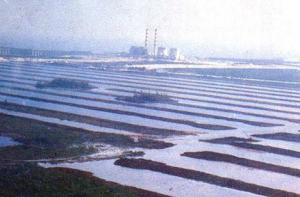Water securityFlorida’s Turkey Point nuke pollutes Biscayne Aquifer, Biscayne National Park
Contaminated water originating from the cooling canal system at Florida Power & Light’s (FPL) Turkey Point facility is reaching Biscayne Bay, threatening South Florida’s drinking water supply and Biscayne National Park. The facility is one of Florida’s biggest daily water users and discharges at least 600,000 pounds of salt and other contaminants directly into the Biscayne Aquifer on a daily basis. The Biscayne Aquifer is a “sole source,” federally designated aquifer that serves more than three million people.

Over 10 miles of cooling canals at the Turkey Point power plant (shown in the distance) // Source: usgs.gov
Contaminated water originating from the cooling canal system at Florida Power & Light’s (FPL) Turkey Point facility is reaching Biscayne Bay, threatening South Florida’s drinking water supply and Biscayne National Park. The findings and analysis by the Miami-Dade County Department of Environmental Resource Management (DERM) were released by Mayor Carlos Gimenez’s office late yesterday in an official memo to the Miami-Dade Board of County Commissioners. At an 8 March Board meeting, another recent report ordered by the Commission and prepared by the University of Miami (UM) regarding these discharges was discussed as an official agenda topic. Discussion of enforcement options occurred, including possible issuance of a Notice of Violation (NOV) to FPL.
Clean Energy says that the water-intensive Turkey Point site includes two nuclear reactors and is located in Miami-Dade County near Homestead, about twenty-five miles south of downtown Miami. The facility is one of Florida’s biggest daily water users and discharges at least 600,000 pounds of salt and other contaminants directly into the Biscayne Aquifer on a daily basis. The Biscayne Aquifer is a “sole source,” federally designated aquifer that serves more than three million people.
A host of public speakers representing diverse community interests including the national parks, local environmental organizations, and businesses demanded that the Commission act immediately to force FPL to stop this contamination and to research and implement options to actually fix these serious problems. When the Board took up the agenda item, Commissioner Rebeca Sosa commented at length along with fellow Commissioners sharing their concerns and desire for solutions during a lengthy dialogue with Mayor Gimenez and DERM Assistant Director Lee Hefty.
At the meeting, representatives from the Southern Alliance for Clean Energy (SACE) highlighted the severity of this contamination and offered recommendations. These solutions included pursuing affordable clean energy options that are far less water-intensive, such as solar, instead of FPL’s pursuit of two additional nuclear reactors at the beleaguered plant.
“This study confirms that FPL miscalculated the impact uprating Turkey Point’s reactors to generate more power would cause. So this self-inflicted emergency has caused uncontrollable temperatures and an algal bloom and very high salinities. And FPL’s self-prescribed remedy for this emergency, sanctioned by the Department of Environmental Protection and the South Florida Water Management, has now moved that plume into the surface waters of a National Park further violating the law,” said Laura Reynolds, representing SACE. “Why can’t we make FPL downrate this system to bring it back into balance? They continue to make record profits while our water supply gets loaded with at least 600,000 pounds of salt daily and our national park is polluted and drinking water is threatened.”
Separately, upon learning about this new analysis, State Representative José Javier Rodríguez (D-Miami) issued a statement and sent a letter calling on the U.S. Environmental Protection Agency to “step in and take emergency remedial action following a Miami-Dade County report revealing levels of radioactive materials in Biscayne Bay at levels 215 times higher than those in the ocean. Rep. Rodriguez has expressed frustration at what he believes is the Florida Department of Environmental Protection’s repeated failures to protect the public from FPL’s actions at Turkey Point.”
The analysis publicly released on 7 March stated, “The results for tritium provide the most compelling evidence that water originating from the Cooling Canal System is reaching these tidal surface waters connected to Biscayne Bay.” Tritium is a radioactive form of hydrogen that is produced at nuclear power plants and is being used as a tracer given the cooling canal system has higher levels of tritium than what is found in the natural environment.
“Cover up is not an option here. It’s important that all the information is made public, is fully vetted and that a transparent process occurs,” said Dr. Stephen A. Smith, executive director of SACE. “Let’s also remember that the uprate at Turkey Point constituted new nuclear generation which allowed FPL to charge their customers in advance for those costs due to the early nuclear cost recovery statute that the state legislature passed years ago. So, the irony here is that FPL’s desire to run this plant harder and make more money has now backfired and serious problems have occurred, resulting in contamination and likely much more money having to be spent to fix this problem that likely could have been avoided in the first place.”
